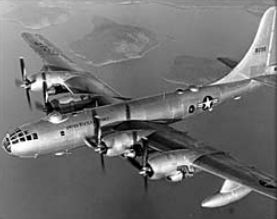| Lucky Lady II | |
|---|---|
| A similar but later B-50D | |
| Type | Boeing B-50A Superfortress |
| Construction number | 15730 |
| Serial | 46-0010 |
| Owners and operators | United States Air Force |
| In service | 1948-1950 |
| Fate | Badly damaged in accident - Fuselage preserved |
| Preserved at | Planes of Fame Museum in Chino, California |
Lucky Lady II is a United States Air Force Boeing B-50 Superfortress that became the first airplane to circle the world nonstop when it made the journey in 1949, assisted by in-flight refueling. Total time airborne was 94 hours and 1 minute. After an accident, only the fuselage is preserved. (Lucky Lady II was also the name of a B-17 of the 338th Bomb Squadron, which was shot down near Tielrode (Temse), Belgium, on 30 July 1943.)
[]
The Lucky Lady II was a functioning B-50 of the 43rd Bombardment Group, equipped with 12 .50-caliber machine guns, with an additional fuel tank added in the bomb bay to provide additional range. The plane had a double crew with three pilots, with each crew taking a shift of four to six hours on duty and four to six hours off.[1][2]
The plane started its round-the-world trip with a crew of 14 under the supervision of Capt. James Gallagher at 12:21 PM on February 26, 1949, from Carswell Air Force Base in Fort Worth, Texas, heading east over the Atlantic Ocean. After flying 23,452 miles (37,742 km), the plane passed the control tower back at Carswell AFB on March 2 at 10:22 AM, marking the end of the circumnavigation, and landed there at 10:31 AM after being in the air for 94 hours and one minute, landing two minutes before the estimated time of arrival calculated at take-off. En route, the plane was refueled four times by B-29 Superfortresses converted into aerial refueling tankers, meeting up above Lajes Air Force Base in the Azores, Dhahran Airfield in Saudi Arabia, Clark Air Force Base in the Philippines, and Hickam Air Force Base in Hawaii, using the soon-to-be obsolete grappled-line looped-hose technique. The plane flew at altitudes between 10,000 to 20,000 feet (3,000 to 6,100 m) and completed the trip around the world at an average ground speed of 249 miles per hour (401 km/h).[1]
Lieutenant General Curtis LeMay, Strategic Air Command's commanding general, was on hand to greet the Lucky Lady II upon its arrival, together with dignitaries including Secretary of the Air Force W. Stuart Symington, Air Force Chief of Staff General Hoyt S. Vandenberg, and Major General Roger M. Ramey, commanding general of the Eighth Air Force. LeMay cited the significance of the mission as indicating that the Air Force now had the capability to take off on bombing missions from anywhere in the United States to "any place in the world that required the atomic bomb".[1] He further stated that mid-air refueling could also be used for fighter aircraft. Symington noted that aerial refueling would "turn medium bombers into inter-continental bombers".[1]
The plane's crew was honored by the National Aeronautic Association with its annual Mackay Trophy recognizing the outstanding flight of the year and by the Air Force Association with its Air Age Trophy.[2]
Another B-50 had taken off on February 25 with the same mission, but was forced to land in the Azores due to an engine fire.[1]
Other Lucky Ladies[]
Lucky Lady II was one of three similarly named aircraft, each of which was part of an historic circumnavigation on behalf of the United States Air Force:
Lucky Lady I was one of two Boeing B-29 Superfortresses that made a round-the-world trip in July–August 1948, flying from and back to Davis-Monthan Air Force Base in Arizona, completing the 20,000 miles (32,000 km) flight in 15 days after making eight stops along the way and flying for 103 hours and 50 minutes.[2]
Lucky Lady III was one of three Boeing B-52 Stratofortresses that made the circumnavigation in January 1957 as part of Operation Power Flite, flying from Castle Air Force Base in California and completing the 24,325 miles (39,147 km) flight in 45 hours and 19 minutes (at an average ground speed of 536 miles per hour (863 km/h)) with the assistance of aerial refueling from KC-97 Stratotankers. Eight years after Lady II, Lady III made the trip around the world in under half the time required by Lady II.[2]
Current status[]

Lucky Lady II in 2002
The fuselage of the plane, designated B-50A-5BO 46-0010, is on display at Planes of Fame Museum in Chino, California.[3][4]
See also[]
- Operation Power Flite - B-52 around-the-world simulated bombing mission in 1957, with a total time airborne of 45 hours and 19 minutes
- Coronet Bat - B-1B around-the-world bombing mission in 1995, with a total time airborne of 36 hours and 13 minutes
References[]
- ↑ 1.0 1.1 1.2 1.3 1.4 Waggoner, Walter H. "FIRST IN HISTORY; High Officials Greet the Plane as It Ends Hop at Fort Worth", The New York Times, March 3, 1949. Accessed September 1, 2009.
- ↑ 2.0 2.1 2.2 2.3 Lucky Ladies, Air Force Historical Studies Office. Accessed September 2, 2009.
- ↑ Lucky Lady II, Air Force Magazine, March 1999. Accessed September 1, 2009.
- ↑ Home Page, Planes of Fame Museum. Accessed September 1, 2009.
External links[]
- Factsheets: Boeing B-50A "Lucky Lady II" at National Museum of the U.S. Air Force website
- The short film 15 AF HERITAGE - HIGH STRATEGY - BOMBER AND TANKERS TEAM (1980) is available for free download at the Internet Archive [more]
The original article can be found at Lucky Lady II and the edit history here.
